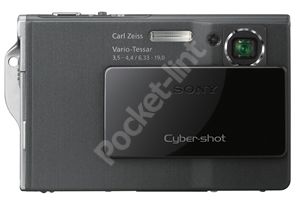Sony's latest digital compact is even smaller than the last. Following in the footsteps of the T3 and T5 models, the DSC-T7 promises great photographs from an ultra thin body, but can it really achieve what it promises. Pocket-lint was one of the first to find out.
Our quick take
I think the word to apply to the T7 is “disappointment”. The slim body and large screen will appeal because the size and design certainly has that wow factor, but poor images and issues over battery life means that you'll only going to be upset that you didn't capture that magic moment either because your battery had died or the photograph taken was flat. It seems that perhaps style has won over on function this time and that is a great shame. If you're looking for compact and great photos then it's still Casio or Pentax that rule this sector.

Sony DSC-T7 digital camera - 3.0 / 5
| FOR | AGAINST |
|---|---|
|
|
The camera without a doubt is small, measuring 92 x 60 x 15 mm (3.6 x 2.4 x 0.6 in) in its dimensions. Even loaded up with battery and a Memory Stick Duo card it weight in at 134g (4.7oz).
Like the T3, the biggest single element to the camera is the screen, and considering the dimensions above, Sony has still managed to put a 2.5in 230k screen on the back so you can see everything clearly. As you can see from the accompanying images the screen takes up most of the back of the unit and while this means that you have plenty of chance to see the photographic subject, it does come with its problems.
Firstly, that the drain on the battery is unbelievable. We were given a full charged battery and within an hour of use (and not really using the flash) we were already running low on juice. The second is that there's no optical viewfinder on the T7. While we realise that more and more compacts are being made without an optical viewfinder, with such a large screen that has such a high battery drain it would have made sense to include an option that didn't mean you had to rely on the power guzzling screen (or guesswork). Screen aside, the model is well crafted, the front lens cap, different from the T3, may cause issues and while some will like it, others like ourselves think it's just a bit of metal bolted on for effect.
The division between onscreen menus and shortcuts on the rear of the unit is well balanced and switching from different settings, whether ISO or white balance, was very easy. For the would-be photographer, you get considerable manual control and you can even get a live histogram on screen for honing your images on the fly.
In tests we did find the zoom slightly cumbersome. Additionally the combination of such a thin design and the lens situated at the top left of the model, we did initially find some of our test shots had fingers in the way. This was soon corrected and to be honest probably more our fault rather than the design of the camera.
With a 1/2.4in 5 megapixel Super HAD CCD the camera packs a punch when it comes to images. There are five image settings to choose from the top being 2592x1944 and the bottom being 640x480. The unit comes with a 32Mb card and you can expect to get around 20 shots for your money.
The optical zoom is a standard 3x and the camera also offers a 2x digital zoom, but we really wouldn't recommend bothering with it.
We took a series of shots on a sunny day around a vineyard in Bordeaux. Getting back to the office a couple of days later we were actually rather disappointed with the cameras performance. Even the Auto mode produced flat dulled colours and more worryingly plenty of noise, both in daylight and indoor shots. Even the shots we took with a flash seemed over exposed and too heavy handed.
That said the camera did seem to cope with detail (see woman using phone) and the complicated pattern hasn't washed out in a mass of pixels. Likewise in our test shots of some glasses the camera has coped well.
To recap
Unfortunately this is style over substance
